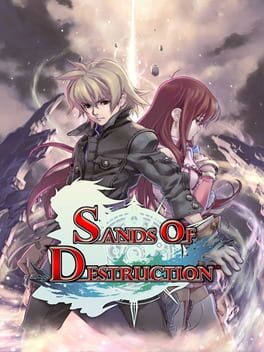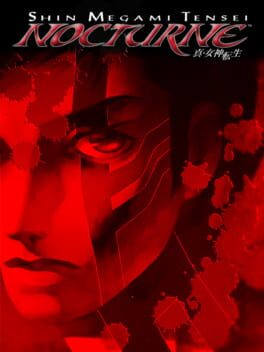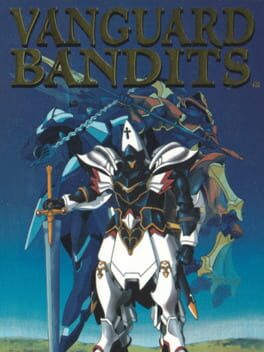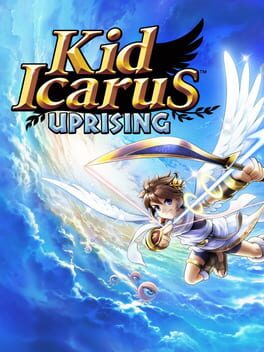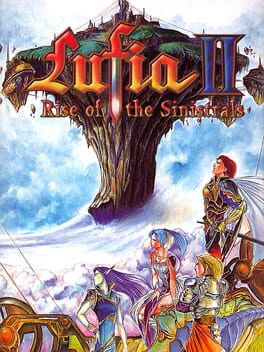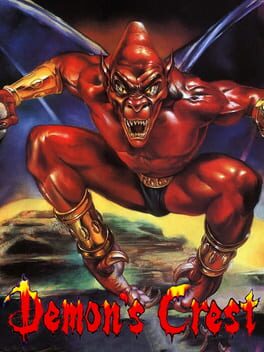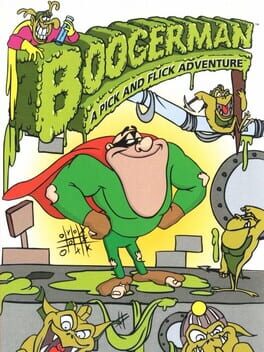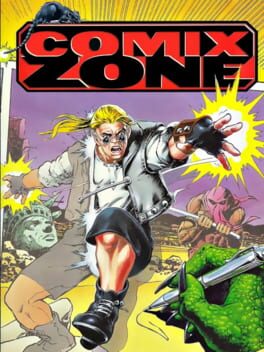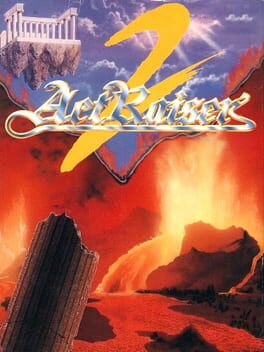Zotol
2008
I try to play some DS RPGs from time to time. I’m a fan of how most use PS1-era graphics, and it can feel like extras from that generation at times. So, when I stumbled across this one and saw who composed the soundtrack, that immediately piqued my interest, and I tried it the following day. I wasn’t familiar with the development team Imageepoch, but then I found out they were the people who made that anime game with the drawn characters in 3D space. Ok, onto the review.
Sands of Destruction uses sprites on 3D areas just like many 5th-gen RPGs, and it looks good enough. There aren't really many memorable areas, but they do at least look like there was effort put into them. It doesn’t help that this game uses one of those point-A to point-B world map layouts, which, in my opinion, absolutely kills RPG world building. It makes the progression simpler, but it just looks bland. The soundtrack for this game is pretty good though! It’s composed by Yasunori Mitsuda, who composed the soundtracks for Chrono Trigger, Xenogears, and many others. It's not as good as those game's soundtracks, but it’s still great. It sounds a lot like Xenogears, but it’s the same person, so… no surprise.
The story is also really bland, mostly due to the lack of original ideas. It’s the same tired theme of humans and beasts hating each other, and this game gives barely any background on the situation. Also not helping are the characters, which aren’t awful, but they certainly aren’t good. They dump all their backstories quickly at once near the end of the game, and they don’t really get any time to be fleshed out. There’s also voice acting in a lot of the cutscenes, and to be honest, it’s alright. The main character's voice actor sounds like he barely gives a shit when anything serious is happening, but other than that, I don’t think I’m dissatisfied with a 2008 DS game's voice acting.
This game's difficulty was apparently altered during its localization, and I don’t know if that means harder or easier because I genuinely cannot find any information on it. Whether it was either of those, this game is laughably easy to the point where it’s mind-numbing. I’m talking one-shot every enemy for most of the game easy. Hell, at one point in the game, I was able to one-shot a boss. Yes, I’m serious. Although the game is very easy, I can at least respect that it doesn’t hold your hand constantly. Most DS games will not be shy about over-explaining literally everything, but this game feels like it carries more game design philosophies from previous console generations than its own.
The combat system is flawed, but it has some good ideas that are unfortunately laid to waste due to the game's laughably easy difficulty. I have to explain it since that ties into why the game is easy. It’s a little tricky to explain, but it’s not as complicated as it may seem. So, each character has blunt attacks and flurry attacks. Blunt attacks are one-hit strong attacks, which aren’t even remotely useful as they barely do any damage, and flurry attacks are multi-hit attacks, which I can only assume were meant to be weaker even though they do much more damage than the blunt attacks due to the large amount of hits that do a ton of damage. Your characters have 3 of each, and you can combo all 3 blunt/flurry attacks if you have enough battle points. Time to explain those too! Characters will start with 2 battle points, or it may go up or down 1 due to character morale, which, to my knowledge, is random when starting a battle. These basically act as character actions and let you attack, use magic, and whatnot. If you get a crit or surpass an interval of 10 on your combo meter, you get an extra battle point; this will be important in a second. Regarding the combat system, there’s also customization points, and in case anybody was wondering, yes, they do use an acronym for it in-game. You get these after battles and can use them to level up moves for your characters. Upon leveling up your flurry move 7 times, you have the option to chain it to your other flurry moves, which will make it so every time you use a flurry move, it will use the next flurry advancement in the combo without using another battle point. This will make it so that with most characters, you’ll be able to reach 10 hits in one turn, which grants another turn in battle, effectively creating an infinite attack loop until you max out at 7 battle points, which forces you to use a special attack, special magic, or defend. Special attacks in this game are extremely weak and never worth using, just like the blunt attacks. The game's balancing is super disjointed, and the combat system is not fleshed out properly. I like the idea of gaining turns for combos and using those turns to use magic, buff, or defend, but there’s no point when you’re not being challenged. I was just doing the exact same thing every battle, and that, paired with this game's large encounter rate, which made me very over-leveled, made it feel like a giant drag.
This game has some missed potential, but I can’t lie to myself; I had no fun playing this game. If you want a good DS RPG to play, just go play Radiant Historia. That’s not a perfect game either, but it’s much better than this.
Sands of Destruction uses sprites on 3D areas just like many 5th-gen RPGs, and it looks good enough. There aren't really many memorable areas, but they do at least look like there was effort put into them. It doesn’t help that this game uses one of those point-A to point-B world map layouts, which, in my opinion, absolutely kills RPG world building. It makes the progression simpler, but it just looks bland. The soundtrack for this game is pretty good though! It’s composed by Yasunori Mitsuda, who composed the soundtracks for Chrono Trigger, Xenogears, and many others. It's not as good as those game's soundtracks, but it’s still great. It sounds a lot like Xenogears, but it’s the same person, so… no surprise.
The story is also really bland, mostly due to the lack of original ideas. It’s the same tired theme of humans and beasts hating each other, and this game gives barely any background on the situation. Also not helping are the characters, which aren’t awful, but they certainly aren’t good. They dump all their backstories quickly at once near the end of the game, and they don’t really get any time to be fleshed out. There’s also voice acting in a lot of the cutscenes, and to be honest, it’s alright. The main character's voice actor sounds like he barely gives a shit when anything serious is happening, but other than that, I don’t think I’m dissatisfied with a 2008 DS game's voice acting.
This game's difficulty was apparently altered during its localization, and I don’t know if that means harder or easier because I genuinely cannot find any information on it. Whether it was either of those, this game is laughably easy to the point where it’s mind-numbing. I’m talking one-shot every enemy for most of the game easy. Hell, at one point in the game, I was able to one-shot a boss. Yes, I’m serious. Although the game is very easy, I can at least respect that it doesn’t hold your hand constantly. Most DS games will not be shy about over-explaining literally everything, but this game feels like it carries more game design philosophies from previous console generations than its own.
The combat system is flawed, but it has some good ideas that are unfortunately laid to waste due to the game's laughably easy difficulty. I have to explain it since that ties into why the game is easy. It’s a little tricky to explain, but it’s not as complicated as it may seem. So, each character has blunt attacks and flurry attacks. Blunt attacks are one-hit strong attacks, which aren’t even remotely useful as they barely do any damage, and flurry attacks are multi-hit attacks, which I can only assume were meant to be weaker even though they do much more damage than the blunt attacks due to the large amount of hits that do a ton of damage. Your characters have 3 of each, and you can combo all 3 blunt/flurry attacks if you have enough battle points. Time to explain those too! Characters will start with 2 battle points, or it may go up or down 1 due to character morale, which, to my knowledge, is random when starting a battle. These basically act as character actions and let you attack, use magic, and whatnot. If you get a crit or surpass an interval of 10 on your combo meter, you get an extra battle point; this will be important in a second. Regarding the combat system, there’s also customization points, and in case anybody was wondering, yes, they do use an acronym for it in-game. You get these after battles and can use them to level up moves for your characters. Upon leveling up your flurry move 7 times, you have the option to chain it to your other flurry moves, which will make it so every time you use a flurry move, it will use the next flurry advancement in the combo without using another battle point. This will make it so that with most characters, you’ll be able to reach 10 hits in one turn, which grants another turn in battle, effectively creating an infinite attack loop until you max out at 7 battle points, which forces you to use a special attack, special magic, or defend. Special attacks in this game are extremely weak and never worth using, just like the blunt attacks. The game's balancing is super disjointed, and the combat system is not fleshed out properly. I like the idea of gaining turns for combos and using those turns to use magic, buff, or defend, but there’s no point when you’re not being challenged. I was just doing the exact same thing every battle, and that, paired with this game's large encounter rate, which made me very over-leveled, made it feel like a giant drag.
This game has some missed potential, but I can’t lie to myself; I had no fun playing this game. If you want a good DS RPG to play, just go play Radiant Historia. That’s not a perfect game either, but it’s much better than this.
(This review is my old take on Nocturne. It’s a very negative view of the game but I actually like Nocturne now. I completed the HD port and this is my more recent review for it.)
I want to like this game but I can't. This is one of the worst designed JRPGs I have ever played.
First let's start with this game's so-called "Difficulty". The only difficult thing I had to do in this game was use an insta kill shield before going back to auto battling. 90 percent of the boss fights in this game are an absolute joke. This is mostly due to evasion buffs being one of the most broken things in the game.
One of this games stand out mechanics is its "Press Turn System" which essentially allows you to transfer a turn to the next party member. Here's the catch though. If you get a crit you get another turn, but, if you miss your attack you lose 2 turns out of the 4 it gives you per player phase. This also applies to enemies which includes boss fights. This system is extremely abusable due to evasion buffs and debuffs. I was literally just using evasion up over and over again for every boss fight and then the bosses would miss their attack and not get a chance to do anything so I could continue auto battling with no repercussions. The good thing is sometimes they will have moves to remove debuffs on themselves or remove your buffs. I've barely seen these moves used though and most of the time the bosses were at the end of the game. Even still, the bosses are super unbalanced and extremely easy to beat. Oh, but there's also the bosses which have gimmicks like being immune to physical damage. So you can sit there for 10 minutes trying to use magic moves (which are very weak in this game) in a stall match waiting for enough turns to use the weak spells as the boss does 2 damage to you and wastes their turns because of the evasion buffs you have.
Now, my biggest problem with this game is the dungeon design. They decided to resort to picking a random path in dungeons for progression. It's super cool when the final dungeon in the game's gimmick is picking a path. If you pick the wrong one you get sent back to the beginning, which is really fun because of the random encounter rate! I swear any time this game has puzzles it's just hoping you went in the right door or area and hope you don't have to start over (which you will).
If you want to fight the fiends then I hope you remembered you probably should go back to the starting area halfway through the game for no apparent reason with no NPC in areas but the place mentioned having any hints or info on the subject. Every time I had to fight a fiend I was literally just going down the checklist of every area in the game including all of the little rooms scattered about in the towns.
The Demon Fusion system is really cool in concept but I wish it made some semblance of sense. It's not touched on beyond the fusion room guy telling you very basic info. It is basically just throwing shit at a wall and hoping it sticks. Hope you can fuse whatever you need from luck alone. I can't help but think that there are ways to make this system more understandable for a blind player, like possibly a graph displaying possible fusions and filling in with the fusions you've already created.
The story is not very good too, which sucks because the concept is actually very interesting. The world is wiped and there is a battle of reasons to determine how the new world will be run. The problem is that the characters have very unrealistic motivations (save for Futomimi) and are barely given any time for me to care about them, or maybe understand where they are coming from.
This is just the surface of this game's issues, there are plenty more but, I would be here all day. But, besides that I will say that I do like the art and world design in this game. It gives off a very unique feel I've never experienced before in a video game. That alone, was the only thing I can take away from this experience that I appreciated, along with some of the songs in the soundtrack.
I want to like this game but I can't. This is one of the worst designed JRPGs I have ever played.
First let's start with this game's so-called "Difficulty". The only difficult thing I had to do in this game was use an insta kill shield before going back to auto battling. 90 percent of the boss fights in this game are an absolute joke. This is mostly due to evasion buffs being one of the most broken things in the game.
One of this games stand out mechanics is its "Press Turn System" which essentially allows you to transfer a turn to the next party member. Here's the catch though. If you get a crit you get another turn, but, if you miss your attack you lose 2 turns out of the 4 it gives you per player phase. This also applies to enemies which includes boss fights. This system is extremely abusable due to evasion buffs and debuffs. I was literally just using evasion up over and over again for every boss fight and then the bosses would miss their attack and not get a chance to do anything so I could continue auto battling with no repercussions. The good thing is sometimes they will have moves to remove debuffs on themselves or remove your buffs. I've barely seen these moves used though and most of the time the bosses were at the end of the game. Even still, the bosses are super unbalanced and extremely easy to beat. Oh, but there's also the bosses which have gimmicks like being immune to physical damage. So you can sit there for 10 minutes trying to use magic moves (which are very weak in this game) in a stall match waiting for enough turns to use the weak spells as the boss does 2 damage to you and wastes their turns because of the evasion buffs you have.
Now, my biggest problem with this game is the dungeon design. They decided to resort to picking a random path in dungeons for progression. It's super cool when the final dungeon in the game's gimmick is picking a path. If you pick the wrong one you get sent back to the beginning, which is really fun because of the random encounter rate! I swear any time this game has puzzles it's just hoping you went in the right door or area and hope you don't have to start over (which you will).
If you want to fight the fiends then I hope you remembered you probably should go back to the starting area halfway through the game for no apparent reason with no NPC in areas but the place mentioned having any hints or info on the subject. Every time I had to fight a fiend I was literally just going down the checklist of every area in the game including all of the little rooms scattered about in the towns.
The Demon Fusion system is really cool in concept but I wish it made some semblance of sense. It's not touched on beyond the fusion room guy telling you very basic info. It is basically just throwing shit at a wall and hoping it sticks. Hope you can fuse whatever you need from luck alone. I can't help but think that there are ways to make this system more understandable for a blind player, like possibly a graph displaying possible fusions and filling in with the fusions you've already created.
The story is not very good too, which sucks because the concept is actually very interesting. The world is wiped and there is a battle of reasons to determine how the new world will be run. The problem is that the characters have very unrealistic motivations (save for Futomimi) and are barely given any time for me to care about them, or maybe understand where they are coming from.
This is just the surface of this game's issues, there are plenty more but, I would be here all day. But, besides that I will say that I do like the art and world design in this game. It gives off a very unique feel I've never experienced before in a video game. That alone, was the only thing I can take away from this experience that I appreciated, along with some of the songs in the soundtrack.
1998
I haven't played many SRPGs... When I was a kid I managed to do the worst possible run of FE7 anyone has ever seen. I got stuck on chapter 18 or something and was forever saddened that I had wasted hours dedicated to an unsalvageable run. Ever since then I've shuttered at the idea of playing SRPGs with railroading progression. History has changed though, as I have finally done what I have been scared to do my entire life and finished a playthrough of an SPRG.
The story is nothing special, but it's executed very well. It's an RPG war plot where you have to build a team to go fight the evil empire. Nothing crazy there of course, although the characters were definitely the driving force for me to care about it. They're tropey, but it's satisfying to see their developments play out. They feel like they're all great friends too; kind of gave me some Lunar vibes as far as that goes. Working Designs did good with the localization this time too. I think they added more life into a would-be dull story. Their signature "humor" is present here while they still know how to have their serious moments in the story too. They got a few laughs out of me this time around, but it was equally paired with some cringey moments as well. I have Working Designs Stockholm syndrome though, so I'm biased. There's also different story routes you can take with exclusive characters, maps, and so on. I eventually want to go back for a replay to see the other content since it seems interesting.
The gameplay is different from the SRPGs I've played. You characters pilot "All Terrain Armored Combatants" also known as "Mechs!" Upon entering battles it loads in a new environment as you watch the 3D mech battles play out. They look cool, however I usually like turning this stuff off as I have difficulty remembering my strategies when I have to pause and watch what are essentially cutscenes in-between my movements. One of the most notable things to me at least is that there's very limited ways to heal your team, so you'll have to minimize taking damage in any way you can. I know that's like a "no shit" for video games, but.. yeah. The way you do this is by flanking the enemy from behind so they're not able to counter-attack you and so you do more damage. You're also able to pick a direction upon moving so you can hopefully prevent getting flanked yourself. I was happy to find out upon playing that this game does not have perma-death. If a unit dies they'll just be out of the game until the next chapter. There's no way to bring them back in the current battle, but at least I didn't have to reset constantly when I got RNG fucked a few times. When leveling up you're also able to distribute a few stats to your character. This is a cool layer of customizability since you can dump a bunch of points into a stat that a character is currently struggling with. There's also special moves characters can learn when they reach enough points in certain stats. I wish that was touched on better since I had no idea when I was playing, so just keep that in mind I guess... or don't. There's a bunch of nuances to the combat but I'll let y'all figure out the rest for yourselves. It's fun stuff.
When I was forced to manage EXP better, it did make the experience very engaging. I basically completed the game in a day since I was having so much fun with it. I don't think this game is very beginner friendly though. I was definitely getting my ass beat at the end and thought I wouldn't even be able to finish it. Luckily, from some God-given miracle, I was able to pull through. Vanguard Bandits is definitely worth giving a go despite the challenge. I might just be ass at video games, but even so... put on your thinking cap when you're playing this one.
The story is nothing special, but it's executed very well. It's an RPG war plot where you have to build a team to go fight the evil empire. Nothing crazy there of course, although the characters were definitely the driving force for me to care about it. They're tropey, but it's satisfying to see their developments play out. They feel like they're all great friends too; kind of gave me some Lunar vibes as far as that goes. Working Designs did good with the localization this time too. I think they added more life into a would-be dull story. Their signature "humor" is present here while they still know how to have their serious moments in the story too. They got a few laughs out of me this time around, but it was equally paired with some cringey moments as well. I have Working Designs Stockholm syndrome though, so I'm biased. There's also different story routes you can take with exclusive characters, maps, and so on. I eventually want to go back for a replay to see the other content since it seems interesting.
The gameplay is different from the SRPGs I've played. You characters pilot "All Terrain Armored Combatants" also known as "Mechs!" Upon entering battles it loads in a new environment as you watch the 3D mech battles play out. They look cool, however I usually like turning this stuff off as I have difficulty remembering my strategies when I have to pause and watch what are essentially cutscenes in-between my movements. One of the most notable things to me at least is that there's very limited ways to heal your team, so you'll have to minimize taking damage in any way you can. I know that's like a "no shit" for video games, but.. yeah. The way you do this is by flanking the enemy from behind so they're not able to counter-attack you and so you do more damage. You're also able to pick a direction upon moving so you can hopefully prevent getting flanked yourself. I was happy to find out upon playing that this game does not have perma-death. If a unit dies they'll just be out of the game until the next chapter. There's no way to bring them back in the current battle, but at least I didn't have to reset constantly when I got RNG fucked a few times. When leveling up you're also able to distribute a few stats to your character. This is a cool layer of customizability since you can dump a bunch of points into a stat that a character is currently struggling with. There's also special moves characters can learn when they reach enough points in certain stats. I wish that was touched on better since I had no idea when I was playing, so just keep that in mind I guess... or don't. There's a bunch of nuances to the combat but I'll let y'all figure out the rest for yourselves. It's fun stuff.
When I was forced to manage EXP better, it did make the experience very engaging. I basically completed the game in a day since I was having so much fun with it. I don't think this game is very beginner friendly though. I was definitely getting my ass beat at the end and thought I wouldn't even be able to finish it. Luckily, from some God-given miracle, I was able to pull through. Vanguard Bandits is definitely worth giving a go despite the challenge. I might just be ass at video games, but even so... put on your thinking cap when you're playing this one.
2012
This system clearly was not designed for a game like this, but they still tried to make it work, and it just doesn't.
The game has on-rail shooter levels and on ground levels. The on-rail shooter levels are fine since you just need to move and shoot, but the on ground levels are where this game falls flat. There's various different control methods but the one I found the most comfortable (it's not) was the stylus circle pad hybrid where you control the camera with the stylus, move with the stick, and attack with the L button. The game expects too much from the player with how limited these control schemes are. I would play a single stage a day and get hand cramps immediately, until I just decided to rush through the rest in one day because I was sick of playing it.
The best thing about this game though is its equivalent of tiktok subway surfers family guy clips on the bottom screen when Palutena and Pit are conversing with various other characters chiming in while you are playing the game. If not for this I would not have finished the game. The voicework is good and the dialogue is usually pretty funny. A lot of the humor is just them making references to old Nintendo games. It should be cringe in theory but it's charming, I'd say.
I would actually like to see this game ported with a proper control scheme to the Switch. I'd probably have a lot more fun with it if I was able to properly appreciate its game design.
The game has on-rail shooter levels and on ground levels. The on-rail shooter levels are fine since you just need to move and shoot, but the on ground levels are where this game falls flat. There's various different control methods but the one I found the most comfortable (it's not) was the stylus circle pad hybrid where you control the camera with the stylus, move with the stick, and attack with the L button. The game expects too much from the player with how limited these control schemes are. I would play a single stage a day and get hand cramps immediately, until I just decided to rush through the rest in one day because I was sick of playing it.
The best thing about this game though is its equivalent of tiktok subway surfers family guy clips on the bottom screen when Palutena and Pit are conversing with various other characters chiming in while you are playing the game. If not for this I would not have finished the game. The voicework is good and the dialogue is usually pretty funny. A lot of the humor is just them making references to old Nintendo games. It should be cringe in theory but it's charming, I'd say.
I would actually like to see this game ported with a proper control scheme to the Switch. I'd probably have a lot more fun with it if I was able to properly appreciate its game design.
Lufia II was one of the later games released on the SNES. Despite the release date, it's graphically unimpressive and looks worse than a lot of SNES RPGs released the same year. It doesn't try to be a Chrono Trigger or an FF6, and it doesn't need to be.
The highlight of this game, especially for me, is its dungeons and puzzles. They're basically just better Zelda dungeons, to be honest. You're given tools throughout the game, and the game design will make great use of them throughout the whole journey. There are also a ton of branching pathways with treasure chests, which, for the most part, have very useful items for your party. I can't stress enough how incredible the head-scratchers are in this game, though. I've yet to find an RPG that even holds a torch to this game in that regard.
This game has an interesting equipment system. Not only do I have to decide which equipment has the best stat allocations for the characters, but there is an IP system in which some equipment pieces will have a special move that you can pick from when your IP meter is charged from taking damage in battle. There are many variables for equipment to take into account in the form of rings and rocks, which all raise different stats and have their own special move most of the time. This game also has shops to learn magic instead of getting spells from leveling up. I like this because I have to choose which character most needs certain spells to not waste all my money. In addition to party members, there is a new type of member called capsule monsters. There are 7 to collect in the game, and you can evolve all of them by feeding them equipment, items, or whatever they desire in the form of a menu telling you what to feed them. This was fun, as they could all help out a bit in their respective manners.
My only complaint about Lufia II is that the characters and story are really boring. The pacing is bad later on in the story, as it starts to get really repetitive and the characters are not interesting at all. They don't get any development for the most part, instead substituting for bad humor in the cutscenes. The gameplay more than makes up for it though!
My favorite SNES game, without a doubt. It's a shame that this series kind of gets neglected now, only getting a mid remake on the DS in 2010. The series as a whole isn't very good, to be honest, with this being the only one worth playing, and it is very much worth playing.
The highlight of this game, especially for me, is its dungeons and puzzles. They're basically just better Zelda dungeons, to be honest. You're given tools throughout the game, and the game design will make great use of them throughout the whole journey. There are also a ton of branching pathways with treasure chests, which, for the most part, have very useful items for your party. I can't stress enough how incredible the head-scratchers are in this game, though. I've yet to find an RPG that even holds a torch to this game in that regard.
This game has an interesting equipment system. Not only do I have to decide which equipment has the best stat allocations for the characters, but there is an IP system in which some equipment pieces will have a special move that you can pick from when your IP meter is charged from taking damage in battle. There are many variables for equipment to take into account in the form of rings and rocks, which all raise different stats and have their own special move most of the time. This game also has shops to learn magic instead of getting spells from leveling up. I like this because I have to choose which character most needs certain spells to not waste all my money. In addition to party members, there is a new type of member called capsule monsters. There are 7 to collect in the game, and you can evolve all of them by feeding them equipment, items, or whatever they desire in the form of a menu telling you what to feed them. This was fun, as they could all help out a bit in their respective manners.
My only complaint about Lufia II is that the characters and story are really boring. The pacing is bad later on in the story, as it starts to get really repetitive and the characters are not interesting at all. They don't get any development for the most part, instead substituting for bad humor in the cutscenes. The gameplay more than makes up for it though!
My favorite SNES game, without a doubt. It's a shame that this series kind of gets neglected now, only getting a mid remake on the DS in 2010. The series as a whole isn't very good, to be honest, with this being the only one worth playing, and it is very much worth playing.
1994
Demon's Crest is the third game in the Gargoyles Quest series. The first two games were platformers with RPG progression, except this game decided to open up the formula and let you tackle levels in your own order, Mega Man style. The difference being that in the Gargoyle's Quest games, they had a linear structure. So, what's the issue here?
This game was not designed around the upgrades it gives you. Even from the very start the game gives you the ability to infinitely hover which allows you to bypass a lot of the level design. This, and other abilities give many sections no challenge. The only instances of this game I remember being a fun challenge was when I did not have a lot of health at the beginning and was forced to learn boss patterns. The bosses are well designed and fun but you can just tank through a lot of them later on. The soundtrack is also pretty boring and repetitive. It's a shame because Gargoyle's Quest 1 and 2 each are designed well and have you utilize your abilities equally throughout the games, instead of this games lack of thought out upgrade distribution.
This game's worth trying if you like permanent character upgrades. Not an awful game, but it still has glaring issues.
This game was not designed around the upgrades it gives you. Even from the very start the game gives you the ability to infinitely hover which allows you to bypass a lot of the level design. This, and other abilities give many sections no challenge. The only instances of this game I remember being a fun challenge was when I did not have a lot of health at the beginning and was forced to learn boss patterns. The bosses are well designed and fun but you can just tank through a lot of them later on. The soundtrack is also pretty boring and repetitive. It's a shame because Gargoyle's Quest 1 and 2 each are designed well and have you utilize your abilities equally throughout the games, instead of this games lack of thought out upgrade distribution.
This game's worth trying if you like permanent character upgrades. Not an awful game, but it still has glaring issues.
I like Silent Hill 2's story and especially it's incredible atmosphere. Although, I had trouble getting attached to the characters due to the voice acting. I was laughing a bit too much at some of the scenes when they're supposed to be serious. It's not out of place for the time it was released in though.
The gameplay is very stagnant. There is not a lot of combat variety as you will be fighting the same 2 zombies over and over again with the same strategy every time. Item distribution feels very unbalanced as well. I had way too much ammo and health pickups by the end of the game while I had used them carelessly whenever I needed. I was disappointed by this because I enjoy when survival horror games have emphasis on resource management and having to make decisions to preserve your inventory without wasting it all. I was playing on normal mode, but it felt like it was on very easy mode or something. I did enjoy the games puzzles for what they were though, along with the excellent soundtrack.
As far as this remaster though? Really good. I'm glad Silent Hill 2 is now properly playable on something that isn't the PS2. I remember it having some glitchy shadows at a part near the end, but other than that, it ran great and looked great.
The gameplay is very stagnant. There is not a lot of combat variety as you will be fighting the same 2 zombies over and over again with the same strategy every time. Item distribution feels very unbalanced as well. I had way too much ammo and health pickups by the end of the game while I had used them carelessly whenever I needed. I was disappointed by this because I enjoy when survival horror games have emphasis on resource management and having to make decisions to preserve your inventory without wasting it all. I was playing on normal mode, but it felt like it was on very easy mode or something. I did enjoy the games puzzles for what they were though, along with the excellent soundtrack.
As far as this remaster though? Really good. I'm glad Silent Hill 2 is now properly playable on something that isn't the PS2. I remember it having some glitchy shadows at a part near the end, but other than that, it ran great and looked great.
I was enticed to play this for obvious reasons but the reality of the matter is that this is an insanely generic and boring platformer with no level variety whatsoever. Every level plays the exact same with the only difference being that the world changes from a pimple theme to a shit theme or something. You could tell me these levels were randomly generated and I would believe it.
The most infuriating thing about this game for me is how much of the screen your sprite takes up. This, paired with the slow booger tossing mechanic which is your main form of attack, makes it so you will constantly run into enemies you can't see unless you're just slowing inching forward, which is what I did for the entire game.
The most infuriating thing about this game for me is how much of the screen your sprite takes up. This, paired with the slow booger tossing mechanic which is your main form of attack, makes it so you will constantly run into enemies you can't see unless you're just slowing inching forward, which is what I did for the entire game.
1995
Comix Zone is a half hour long game that purposefully sets up traps that you can't see coming/react to in time so that you have to keep replaying until you get it right. Conceptually, it's great, with the comic book inspired graphics. Definitely one of the best looking Genesis titles.
This game is known for its difficulty, but it honestly isn't very hard. Once you grind out the game enough and find the best paths to take, there is no challenge left. If I ever replay it, I will struggle minimally since I know all that traps that lie ahead. It was definitely designed this way because of how short the game is, and probably to counter the rental market at the time.
This game is known for its difficulty, but it honestly isn't very hard. Once you grind out the game enough and find the best paths to take, there is no challenge left. If I ever replay it, I will struggle minimally since I know all that traps that lie ahead. It was definitely designed this way because of how short the game is, and probably to counter the rental market at the time.
1993
Disregarding the fact that this sequel dropped it's city sim mechanic from the first game, it is a visually stunning platformer with great enemy and level variety. Although, I do find that the boss design varies in quality. Some are a fun challenge with good patterns that rely on the games mechanics, some are piss-easy, and some have incoherent patterns that I did not feel were fair to fight. Unfortunately I also find the soundtrack to be repetitive and boring. It's unfortunate because Yuzo Koshiro composed the music again coming back from the first game and I don't find it to be nearly as good.
